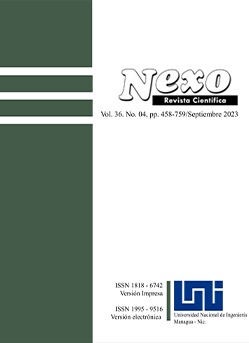Thermo-hydraulic rating of a shell and tube heat exchanger for acetone cooling using bell-delaware method
DOI:
https://doi.org/10.5377/nexo.v36i04.16768Keywords:
Acetone, Bell-Delaware method, Percent excess area, Pressure drop, Rating, Shell and tube heat exchangerAbstract
Shell and tube heat exchangers are becoming the most popular devices for the transfer of heat in industrial process applications. In the present work, the thermo-hydraulic rating of a shell and tube heat exchanger proposed to cool an acetone stream was carried out using the Bell-Delaware methodology. An overall heat transfer coefficient value of 426.70 W/m2.K, a calculated heat transfer area of 121.46 m2, and a percent excess area of 20.83% were obtained. Both the pressure drop of acetone and water had values of 1,622.36 Pa and 3,020.46 Pa, respectively. The proposed shell and tube heat exchanger can be used satisfactorily for the required application, since the percent excess area does not exceed the 25%, and the pressure drops of both fluid streams are below the limit values established by the process.
Downloads
1677
Downloads
Published
How to Cite
Issue
Section
License
Copyright (c) 2023 Universidad Nacional de Ingeniería

This work is licensed under a Creative Commons Attribution 4.0 International License.
The authors who publish in Nexo Scientific Journal agree to the following terms:
- Authors retain the copyright and grant the journal the right of the first publication under the license Creative Commons Attribution License, which allows others to share the work with a recognition of the authorship of the work and the initial publication in Nexo Scientific Journal.
- Authors may separately establish additional agreements for the non-exclusive distribution of the version of the work published in the journal (for example, in an institutional repository or a book), with the recognition of the initial publication in Nexo Scientific Journal.
- Authors are allowed and encouraged to disseminate their works electronically (for example, in institutional repositories or in their own website) before and during the submission process, as it can lead to productive exchanges, as well as earlier and greater citation of published works.










